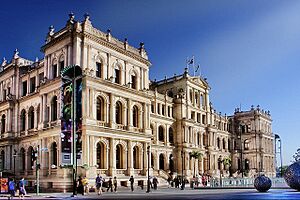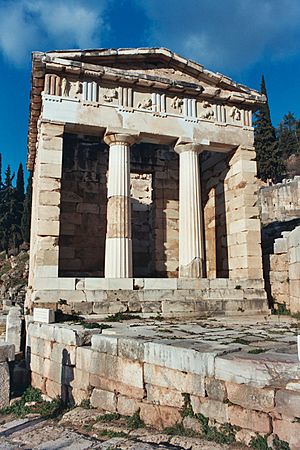Treasury facts for kids
A treasury is a very important word with two main meanings. First, it can be a government department that handles a country's money. This includes things like collecting taxes and managing how the government spends money. Sometimes, this department is called a "finance ministry."
Second, a treasury can be a special place where valuable things are kept safe. This could be a vault where a country stores its money or gold. It could also be a place where kings, churches, or even private collectors keep their precious items.
The person in charge of a treasury is usually called a treasurer. This person helps make sure the money is managed well.
Contents
History of Treasuries
People have been collecting and storing valuable items for a very long time. Some of the oldest gold and silver items found are from Bulgaria, dating back over 6,000 years!
In ancient times, a "treasury" was often a special building where people kept gifts for their gods. For example, in Ancient Greece, cities like Athens built treasuries at important religious sites like Delphi. These buildings held valuable offerings and showed off a city's wealth.
These early treasuries were often part of temples. This made the money and treasures inside them seem sacred and protected. It also made people think twice about trying to steal from them!
In ancient Jerusalem, the king's treasury inside the palace was similar to the temple treasury. The temple treasury even acted a bit like a bank, with special officials managing the money.
The ancient Romans had two main types of treasuries. The aerarium was the treasury for the Roman Senate. The fiscus was the personal treasury used by the Roman emperor.
Treasuries in Government
Today, many countries have a government department called a treasury or a ministry of finance. These departments are in charge of a country's money. They handle the budget, taxes, and how money is spent.
What a Treasury Does
In the United Kingdom, the main money department is called His Majesty's Treasury. It is led by the Chancellor of the Exchequer. The prime minister also holds an honorary title related to the Treasury. The department called His Majesty's Revenue and Customs collects taxes.
In the United States, the United States Department of the Treasury manages the country's money. The United States Secretary of the Treasury is in charge, and the IRS collects taxes.
Ministry of Finance
Many other countries use the name "Ministry of Finance" instead of "Treasury." The person in charge is called the finance minister. Countries like Canada, India, Japan, and New Zealand all have a Ministry of Finance.
Countries with Both
Some countries have both a "Treasury" and a separate "Ministry of Finance." They divide up the jobs between them.
For example, in Australia, there is a Treasurer and a Finance Minister. The Department of the Treasury plans the government's budget and economic policies. The Finance Minister, who leads the Department of Finance, manages how the government spends money.
Treasuries as Storage Places
A treasury can also be a secure room or building where valuable objects are kept. These are often precious items like jewels, gold, or important artworks. They are usually stored in very safe places, like the basement of a palace or a special vault.
State Treasuries
In the past, kings and queens kept their money and treasures in strongholds like the Tower of London in England. Today, most countries keep their gold reserves in their central banks. For example, the gold reserves of the United Kingdom are kept in a vault at the Bank of England.
The United States has the largest gold reserve in the world. Much of it is stored at places like Fort Knox. These treasuries are designed to be very secure and efficient.
Church Treasuries
Many churches, especially large cathedrals, have their own treasuries. These treasuries hold special items that are important for religious reasons. These can include relics (holy objects), icons (religious images), old manuscripts, and special clothing used in services. For example, Aachen cathedral in Germany has many valuable religious artifacts.
Private Treasuries
Throughout history, many people have created their own private collections of interesting and valuable items. These are like personal treasuries. Ancient Roman emperors collected Egyptian obelisks. In medieval times, some rulers had collections of exotic animals, like lions and elephants!
Later, wealthy collectors gathered rare and beautiful objects. Today, famous private collections include the Wallace Collection in Britain and the Getty collection in the United States. These collections are often shared with the public in museums.
See also
 In Spanish: Tesorería para niños
In Spanish: Tesorería para niños
- Bank
- Finance Minister
- Mint
- Treasury management
- HM Treasury (United Kingdom)
- United States Department of the Treasury
- Government bond



